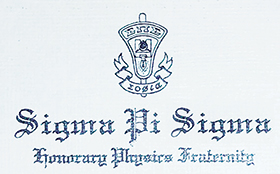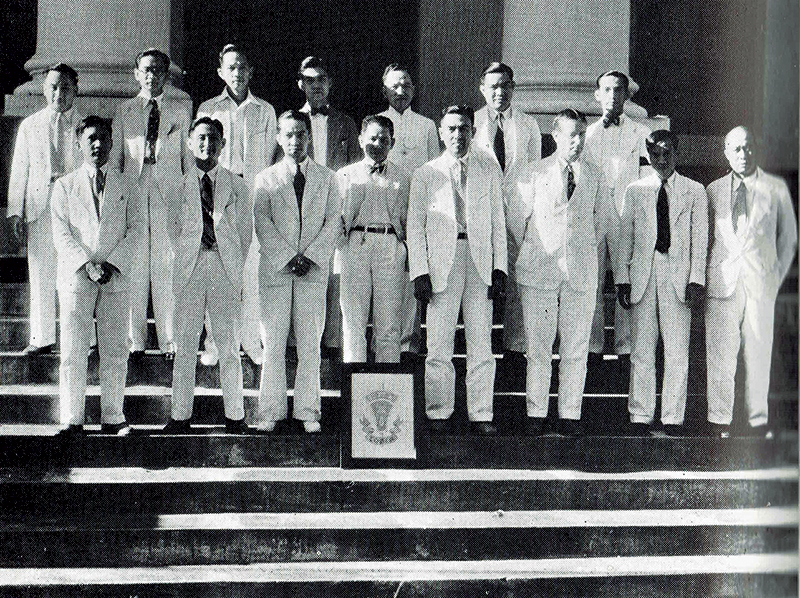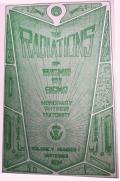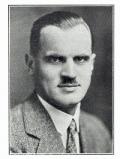Sigma Pi Sigma — A Departmental Legacy of Fellowship Part 3: Developing Community (1930s & ‘40s)
Fall
2020
Unifying Fields
Sigma Pi Sigma — A Departmental Legacy of Fellowship Part 3: Developing Community (1930s & ‘40s)
Brad R. Conrad, Director of SPS and Sigma Pi Sigma, and Earl Blodgett, Historian of SPS and Sigma Pi Sigma
“The objectives of the fraternity shall be to serve as a means of awarding distinction to those of high scholarship and service in physics, to promote interest in the advanced study of the subject, to stimulate and encourage a spirit of cooperation and friendship among those who have displayed marked ability in this study.”
– Original mission of Sigma Pi Sigma,1 as recorded in the Radiations of Sigma Pi Sigma.
 As the fields of physics and astronomy expanded in the first half of the 20th century, so too did the set of activities necessary for Sigma Pi Sigma to achieve its mission. We still honor that same mission today as a linked set of distinct societies, namely, Sigma Pi Sigma and the Society of Physics Students. The original mission statement of the organization, as printed in the 1932 issue of Radiations, is a modified phrasing of the same mission we adhere to today.
As the fields of physics and astronomy expanded in the first half of the 20th century, so too did the set of activities necessary for Sigma Pi Sigma to achieve its mission. We still honor that same mission today as a linked set of distinct societies, namely, Sigma Pi Sigma and the Society of Physics Students. The original mission statement of the organization, as printed in the 1932 issue of Radiations, is a modified phrasing of the same mission we adhere to today.
While it began as a fraternity, it is well established from histories of the founders of the organization that the intent extended beyond that of a traditional fraternity and, instead, focused on community building within physics and service to the broader public.2–4 During a major expansion before World War II, when the society increased from 20 chapters to 43 chapters, Sigma Pi Sigma leaders specifically self-identified as a society. They found that the newly formed Association of College Honor Societies (ACHS) most closely represented who they wished to become—part of a collection of societies that recognized skill and leadership that promoted “desirable standards and useful functions in higher education.”4 Joining would require removing all elements of secrecy, including a secret handshake, and strategically developing strong connections between physics and astronomy departments and their alumni. These core concepts, which we perpetuate by welcoming everyone and that physicists need to support one another, drove the evolution of the organization over the following decades.
As membership in Sigma Pi Sigma expanded to span generations and spread to an ever-growing fraction of departments, the activities and interests of the society expanded as well. Events were regularly scheduled to bring members from different chapters together. For example, yearly luncheons were held at the annual meetings of the American Physical Society as far back as 1932 to encourage members to network (the entrance fee was $1.00).1 On the local level, chapters worked to improve the environment for current and potential undergraduate students by promoting student lounges, which supported retention and recruitment efforts (we can all thank the University of Kentucky’s chapter for the idea).1,5 At the Eta chapter of Chattanooga, students pioneered undergraduate science communication by writing about recent scientific developments for the local school paper.1 Wheaton College offered awards for the best student papers (Ms. Ella Horness was the first reported winner), and Park College kept a “a unique type of bulletin board situated in the hall of the physics building... [which] kept a number of clippings and other scientific reports...[that] have attracted much interest.”1 It’s noteworthy that hallway boards with jobs and news articles were new developments within the community at that time. As early as 1933, Sigma Pi Sigma encouraged chapters to do many of the things that SPS promotes today: hold regular meetings, keep in touch with alumni, donate to scholastic awards, schedule unique department events, and capture an annual chapter picture. Sigma Pi Sigma was a leader in developing best practices for undergraduate physics departments as we know them today.
During this period before WWII, it became commonplace for Sigma Pi Sigma chapters to serve not just their members but also to work toward the improvement of the entire department. Efforts tended to focus specifically on undergraduates and the general public, as there were organizations for professionals and graduate students but no national student organization specifically for undergraduates. The chapters acted as instruments to improve department health and as a network for alumni. Sigma Pi Sigma spread internationally quite early, as the first group chartered outside the continental United States occurred at The University of the Philippines on July 6, 1932, because of a “yearning for a broader field of physics” and connection to a national body.6 These developments were recognized early on by the Sigma Pi Sigma Council, and delegates agreed in 1933 to begin discussions of affiliation with the newly formed “Institute of Physics,” which references the American Institute of Physics (AIP), which published The American Physics Teacher (American Journal of Physics) and The Review of Scientific Instruments with Physics News and Views.6 Meeting notes touch on the desire of the Council to connect students to additional resources and develop professional connections among all students of physics. This began a relationship between the executive secretary of Sigma Pi Sigma, Marsh White, and AIP that ultimately lead to the formation of AIP’s student chapters after World War II and the creation of the Society of Physics Students in 1968.6,7
One of the first collaborations between Sigma Pi Sigma, AIP, and the American Association for the Advancement of Science (AAAS), dating back to 1936, offered recent graduates discounted membership in AIP’s member societies or AAAS.8 It was described as “having as its aim the installation of a more professional spirit among our members” by Marsh White, editor of Radiations at the time.6 This desire to collaborate with the professional physics and astronomy member societies was key to the development of the organization as we know it today. Early on, Sigma Pi Sigma established a custom of working with physics and astronomy Member Society leaders to invite distinguished researchers to give plenary “open meeting” talks at the Physics Congresses. These notable physicists and astronomers, identified by the community, received honorary membership, and many would become active within the society. The history of Sigma Pi Sigma includes many such distinguished researchers, including Arthur H. Compton (cosmic rays), Arthur Haas (Bohr radius), and Edward Teller (fusion), who went on a 3500 mile tour to visit eight chapters and several potential chapters on behalf of Sigma Pi Sigma in 1937.9,10 These types of interactions brought departments and Sigma Pi Sigma closer to the professional societies of the time.
Most professional activities slowed or stopped in the period around World War II, but as soldiers and service people returned from the war, they brought with them a desire to study the technologies which had such an impact on the war’s outcome. Paired with their interest was a large influx of students to universities, fueled, in part, by recent legislation commonly known as the G.I. Bill. This resulted in a huge change for American universities in terms of size, student population, and scope. The new students needed new resources, and the leadership of both Sigma Pi Sigma and many physics departments realized this, which led to a doubling of the organization in four years.7 Around this same time, the formation of the National Science Foundation in 1950, with its mission to promote the progress of science, led to a focus beyond physics research to physics education. The late 1940s and early 1950s became a time of experimentation with student support services, and discussions about how Sigma Pi Sigma and AIP could more effectively work together began in earnest.2,7

References:
1. Marsh W. White, The Radiations of Sigma Pi Sigma 3, no. 1 (1932).
2. Marsh W. White autobiographical account, circa 1955, Niels Bohr Library and Archives.
3. P. Dixon, The History of Sigma Pi Sigma (Oct 1996), accessed October 12, 2020, https://www.sigmapisigma.org/sigmapisigma/about/history.
4. “Homer L. Dodge papers, 1852–1994, Niels Bohr Library and Archives.
5. H. M. Sullivan, “Sigma Pi Sigma Club Chapter Room at Lambda Chapter,” The Radiations of Sigma Pi Sigma 1, no. 2 (Dec 1930).
6. Marsh W. White, The Radiations of Sigma Pi Sigma IV, no. 1 (1933).
7. D. Cunningham, L. W. Seagondollar, C. G. Shugart, A. A. Strassenburg, and Marsh White, “The New Organization of Physics Students,” Physics Today 21, no. 9 (1968): 59, DOI: 10.1063/1.3035154.
8. Marsh W. White, The Radiations of Sigma Pi Sigma 7, no. 1 (1936).
9. Sanford C. Gladden, “New Honorary Members: Biographical Sketches of our New Honorary Members,” The Radiations of Sigma Pi Sigma 2, no. 1 (1932): 31.
10. Sigma Pi Sigma Information Booklet (1939).
Read More
Sigma Pi Sigma – A Departmental Legacy of Fellowship
Part I: Formation and the Early Years www.sigmapisigma.org/sigmapisigma/radiations/issues/fall-2019
Part 2: A Phase Change in the Late 1920s www.sigmapisigma.org/sigmapisigma/radiations/spring/2020/References


